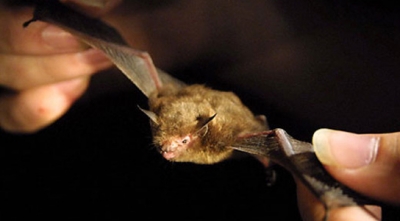
The Kitti’s hog-nosed bat (Craseonycteris thonglongyai), sometimes referred to as the bumblebee bat due to its diminutive size, was discovered in 1970s and could arguably be the world’s smallest mammal, depending on how size is defined.
C. thonglongyai is listed as vulnerable by the IUCN and is found in western Thailand and southeast Burma, in limestone caves along rivers. It is the only existing member of the family Craseonycteridae. Its coat is reddish-brown or gray, with a distinctive pig-like snout. Colonies vary in size, but most have an average of 100 individuals per cave. Some caves will have smaller groups from 10 to 15, while others will have up to 500. The bat feeds in short bursts of activity during evenings and dawn, foraging for insects. Its wings seem to be adapted for hovering flight.
The status in Burma is not well known, but the population in Thailand is restricted to a single province and may be at risk for extinction. The principal threats to its survival are mostly anthropogenic, including habitat degradation and the disturbance of roosting sites.
The bat is about 29 to 33 mm (1.1? to 1.3?) in length and weighs 2 g (0.074 oz). Some small shrews, including the Etruscan shrew (Suncus etruscus), may be lighter but they are longer. C. thonglongyai‘s closest relatives are bats from the families Hipposideridae and Rhinopomatidae.
There’s much about C. thonglongyai that remains unknown. Scientists know little about their reproductive behavior, or how they evade predators. It’s also unknown whether colonies stay in one cave or move around to others. This bat does use echolocation.
Credit : Sci-tech Daily
Picture Credit : Google




